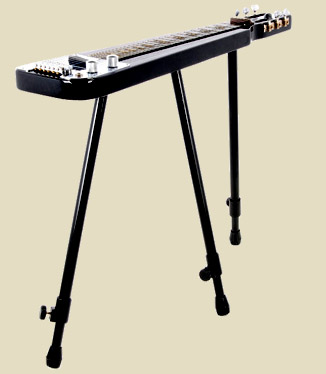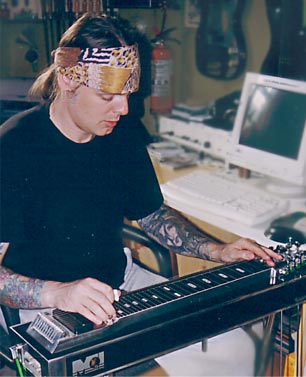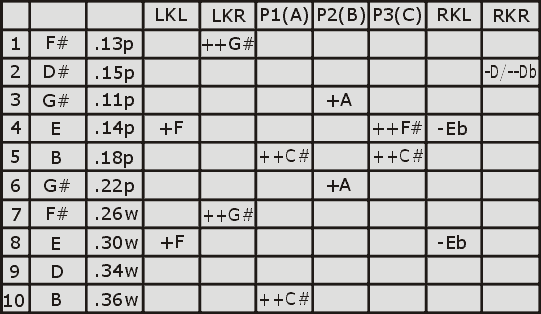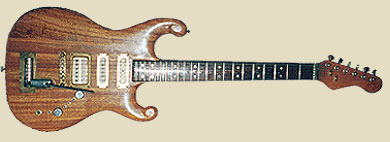Klaus' Instruments
Guitar page.
These instruments have great personal value for me and so they're not for sale. That's why this page is not a catalogue, and the instruments appear as they are - as a logical consequence thereof with dents, scratches and greasy fingers as a part of the impression.

|
Tenayo Console-Steel
Scale: 21,2"/ 53 cm. Notes: Funny but very cheap console-steel (which basically means a lap- |
 |
|
Scale: 24,2"/ 60,5 cm.
Body: Ahorn/Aluminium
Neck: Aluminium
Fretboard: Glued lexan fretmarker
Tuners: Schaller/or Grover m6 mini
Bridge/Changer: 10-strings triple raise/triple lower changer
Pick-up: Barcus Berry
Setup: Emmons (modified)
Steel-bar: Jim Dunlop 7/8" stainless
Notes: After many years of wanting to, I finally pulled myself together and bought this beaty in 2004. A simply fantastic instrument though very difficult to master to perfection. The sound is indescripeable, though most of you probably know it without knowing, as pedal-steel is featured on quite a number of popular record-productions.
Below I've shown my copedent (Chord-pedal-arrangement, for those who doesn't know anything about pedal-steel - It took me quite some time initially, to find out what this funny, non-existent word that popped up all the time, actually meant ;-)

Explanation: From the left the strings are numbered high to low, and the sheet can be viewed as if you were sitting at the players position and looking down at the neck. In the next column the tuning of the respective strings is noted. The following column shows the gauges, where "p" means a plain string and "w" means wound.
The next column shows, as an example, that the outer left kneelever raises the pitch of the E-strings (4 and 8) half a step to F. Two +characters shows that a given string is raised one whole tone (two halfsteps), and precisely the same for the lowering of the tuning (one -character equals lowering a halfstep and so on).
LKL = Outer left kneelever (Left Knee Left)
LKR = Inner left kneelever (Left Knee Right)
RKL = Inner right kneelever (Right Knee Left)
RKR = Outer right kneelever (Right Knee Right)
Note that RKR exclusively lowers the 2' string a halfstep, and then a further halfstep via a "half-stop" or "feel-stop". As LKR's raise of the strings 1 and 7 with two halfsteps isn't standart (Though something I'll like to keep) I'm wondering about performing a slight modification to have a "half-stop" on this kneelever too, in order to get a clearly defined standart change with a halfstep.

|
"Strat" barytone guitar. Build by myself in '83.
Scale: 25,6"/ 64 cm. Bridge p.u.: (Ibanez) Tuning: Barytone (b-e-a-d-f#-b). Notes: Lovely guitar with a sound somewhere between a Stratocaster and a Les Paul. This is probably due to the choice of mahogany for the body and the quite Gibson-like humbucker in the bridge position! All pick-up's can be switched on and off individually, and the humbucker can be split in the positions; coil1/coil2/humbucker. |

|
"Tele" guitar. Build by myself in '78.
Scale: 25,6"/ 64 cm. Bridge p.u. 1: (Hohner- modified) Bridge p.u. 2: (Dane) Tuning: Std. Notes: This is the guitar with the largest number of sound posibilities that I know of. (No wonder! - Check out the scematic). This guitar is able to sound anywhere across the range from the smoothest semi-acoustic to the most earpiercing Jaguar/Tele. Because of the bodys material (teak), which is not exactly known for it's outstanding resonance behaviour, this instrument is unfortunately rather short lived in the high notes. As opposition to that it has real punch in the lows and sounds clear as glass, even after neglecting string change for an extended period. |


|
Lap-steel guitar. modified from old Egmont acoustic guitar by myself in '84.
Scale: 25,2"/ 63 cm. Notes: A funny guitar with a special Dobro-like sound without much sustain. This is probably due to the relatively thick and unresonating top. |
